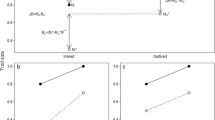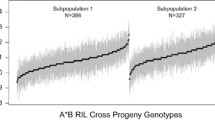Summary
-
1.
The paper deals with genetic variation in the number of ovarioles, which make up the pair of ovaries inDrosophila. Average ovariole number is fairly constant between different wild strains, but within any strain there is great individual variation resulting in a coefficient of variation of about 13%. Comparison of the genetically variable wild flies with genetically uniform flies, under favourable conditions, suggests that about 70 % of this phenotype variation is genetic in origin.
-
2.
Mass selection in a strain for high and low ovariole number led to an asymmetrical response, since selection for lower number led to about 14% reduction, whereas selection in the other direction increased ovariole number by more than 50%, and the response was apparently continuing when the experiment was stopped after ten generations.
-
3.
During selection, the variability in the high line rose above the initial level and then declined and fluctuated around the same level as the low line, which showed no consistent change. The behaviour of the variability, together with the results of intercrossing the high, low and unselected strains, and also back crosses, suggested that a good deal of the response to selection for high ovariole number was due to the increase in frequency and eventual fixation of a recessive gene, which, when homozygous, increases ovariole number by about 25 % over the heterozygous and alternative homozygous combinations. Further evidence of genetic variation tending to cause striking increases in ovariole number was provided by comparison of groups of genetically identical individuals which were created by combining haploid sets of chromosomes from the wild stock with those of an inbred line. Thus the origin of asymmetry in the present selection experiment appears to be quite different from the asymmetry noted in the results of two-way selection for body size.
-
4.
Inbreeding leads approximately to 6 % decline in ovariole number, which is of about the same order as that observed for body size. The variability of ovariole number between individuals is greater in inbred lines than in the crosses between them.
-
5.
When body size is reduced by under-feeding the larvae, there is a proportional reduction in ovariole number and also egg production, but the number of eggs produced per ovariole is unaffected even by striking changes in body size. Lack of correlation between body size and ovariole number or egg production provides a sensitive check on the uniformity of environmental conditions in experiments with genetically identical flies.
-
6.
Provided the larvae have been reared under optimal conditions, individual variation in ovariole number is unimportant with respect to egg production. There is an appreciable ‘chance’ variation between genetically uniform individuals, but this does not involve a correlation with egg production. Selection for low number was accompanied by a slight reduction in the rate at which eggs were laid, while selection in the reverse direction led to a slight increase, but the differences in performance were slight, and somewhat uncertain in origin, compared with the great differences in ovariole number.
-
7.
Independent selection for either high or low ovariole number and large or small size leaves the average value of the other character unchanged so there is no evidence of genetic correlation due to additive effects.
-
8.
The variation in number of ovarioles between the two ovaries of a fly presents a further example of the regional indeterminacy in development which has been referred to as ‘asymmetry’. Under optimal conditions, variation in numbers on the two sides of an individual is uncorrelated, so that most of the non-genetic variation between individuals of a wild strain can be attributed to such chance variation. The level of such variation is the same in inbred lines and wild stocks ; it is a little lower in crosses between inbred lines, but it is uncertain how far this represents a real difference. Also, provided a logarithmic scale is used, the level of such variation turns out to be the same in the high and low selected lines, inbred lines and also wild strains, providing internal evidence of the validity of the log transformation.
-
9.
It is suggested that the high level of ‘chance’ variation and also the considerable genetic variation between individuals of wild strains is related to the capacity of the ovary for physiological regulation, so that, within limits, actual number of ovarioles is of secondary importance. The possibility of detecting striking effects of segregation in such characters may provide otherwise unsuspected evidence of balanced polymorphism.
Similar content being viewed by others
References
Alpatov, W. W. (1929). Growth and variation of the larvae ofDrosophila melanogaster.J. Exp. Zool.52, 407–37.
Bell, A. E.,Moore, G. N. &Warren, D. C. (1956). The evaluation of new methods for the improvement of quantitative characters.Cold Spr. Harb. Symp. Quant. Biol.20.
Clayton, G. A., Morris, J. A. &Robertson, A. (1957). An experimental check on quantitative genetical theory.J. Genet.55, 131–51.
Ealconer, D. S. (1953). Asymmetrical response in selection experiments.I.U.B.S. Symp. Genetics of Population Structure, Pavia, Italy.
Gowen, J. W. (1952).Hybrid vigour in Drosophila.Heterosis. Ames, Iowa.
Macdowell, E. C. (1915). Bristle inheritance inDrosophila. I. Extra bristles.J. Exp. Zool.19, 61–98.
Macdowell, E. C. (1917). Bristle inheritance inDrosophila. II. Selection.J. Exp. Zool.23, 109–46.
Mather, K. (1953). Genetical control of stability in development.Heredity,7, 297–336.
Mather, K. &Harrison, B. J. (1949). The manifold effects of selection.Heredity,3, 1–52, 131-62.
Mather, K. &Wigan, L. G. (1942). The selection of invisible mutations.Proc. Roy. Soc. B,131, 50–64.
Nonidez, J. F. (1920). The internal phenomenon of reproduction inDrosophila.Biol. Bull., Woods Hole,39, 207–30.
Payne, F. (1918). An experiment to test the nature of the variation on Which selection acts.Indiana Univ. Stud.5, no. 36, 45 pp.
Poulson, D. F. (1950). Histogenesis, organogenesis, and differentiation in the embryo ofDrosophila Melanogaster Meig.Biology of Drosophila, chap. III, ed. M. Demerec. New York.
Rabin owipz, M. (1941). Studies on the cytology and early embryology of the egg ofDrosophila melanogaster.J. Morph.69, 1.
Rasmuson, M. (1955). Selection for bristle number in some unrelated strains ofDrosophila melanogaster.Acta Zool. Stockh.,36, 1–49.
Reeve, E. C. R. &Robertson, F. W. (1953). Studies in quantitative inheritance. II. Analysis of a strain ofDrosophila selected for long wings.J. Genet.51, 276–316.
Reeve, E. C. R. &Robertson, F. W. (1954). Studies in quantitative inheritance. VI. Sternite chaeta number inDrosophila: a metameric quantitative character.Z. indukt. Abstamm.-u. Vererblehre,86, 269–88.
Reiff, M. (1945). Fertilitätsstudien anDrosophila melanogaster. II. Eertilitatstypen bei Selektions stämmen, ihr Yerhalten bei Kreuzungen und Transplantationsversuchen.Rev. Suisse Zool.52, 155–211.
Robertson, F. W. (1955). Selection response and the properties of genetic variation.Cold Spr. Harb. Symp. Quant. Biol.20, 166–177.
Robertson, E. W. &Reeve, E. C. R. (1952). Studies in quantitative inheritance I. The effects of selection of wing and thorax length inDrosophila melanogaster.J. Genet.50, 416–48.
Robertson, F. W. &Reeve, E. C. R. (1955a). Studies in quantitative inheritance. VII. Crosses between strains of different body size inDrosophila melanogaster.Z. indukt. Abstamm.-u. Vererblehre,86, 424–38.
Robertson, F. W. &Reeve, E. C. R. (1955b). Studies in quantitative inheritance VIII. Further analysis of heterosis in crosses between inbred lines ofDrosophila melanogaster.Z. indukt. Abstmm.-u. Vererblehre,86, 439–58.
Sang, J. H. (1950). Population growth inDrosophila cultures.Biol. Rev.25, 188–219.
Saviliev, V. I. (1928). Manifold effects of the gene vestigial inDrosophila melanogaster.Trud. Leningr. Obst. Estestv.58, 65–88.
Sonnenblick, B. B. (1950). The early embryology ofDrosophila.Biology of Drosophila, chap. II, ed. M. Demerec. New York.
Sturtevant, A. H. (1918). An analysis of the effects of selection.publ. Garneg. Insln, no. 264, 68 pp.
Author information
Authors and Affiliations
Rights and permissions
About this article
Cite this article
Robertson, F.W. Studies in quantitative inheritance X. Genetic variation of ovary size inDrosophila . J Genet 55, 410–427 (1957). https://doi.org/10.1007/BF02984060
Received:
Issue Date:
DOI: https://doi.org/10.1007/BF02984060




